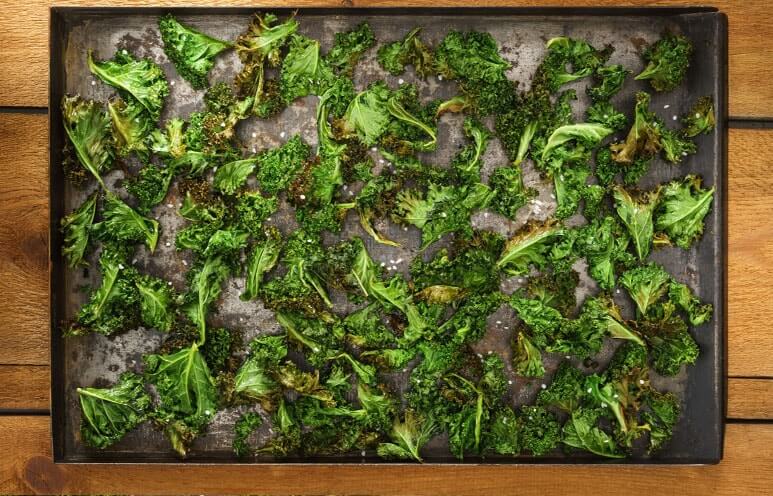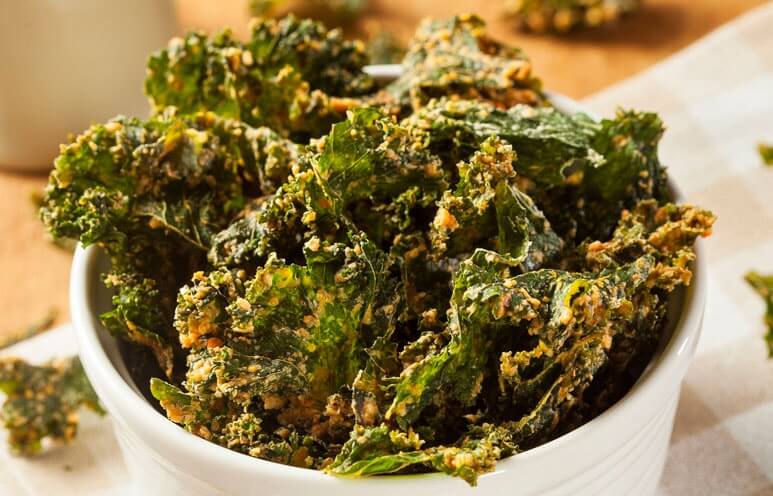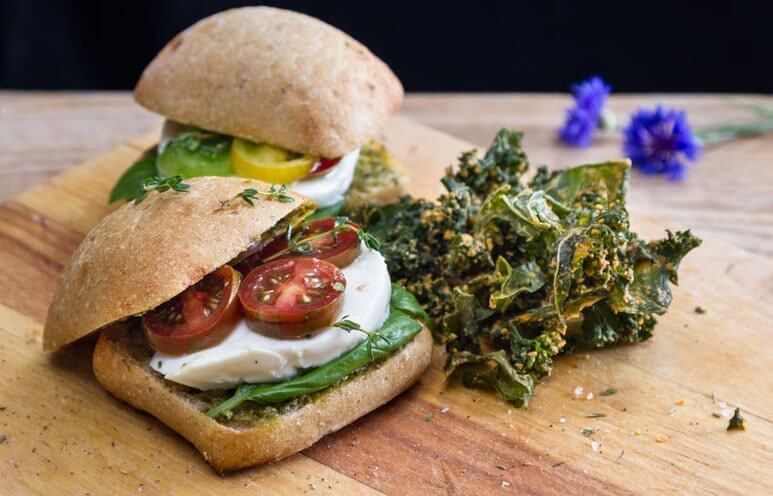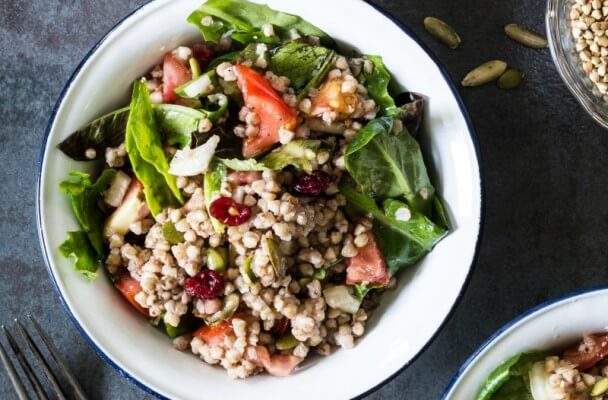6 Reasons You Should Eat Kale Chips Every Day
When your parents told you to “eat your veggies,” you probably didn’t realize that chips counted. But when it comes to kale chips, everything you thought about snack foods is upended. Kale chips are crunchy with an addictive flavor, yet they have few calories and are a source of several essential nutrients.
How to Make Kale Chips

To make kale chips, simply wash and thoroughly dry a bunch of kale. Remove their tough ribs and tear the leaves into small pieces. Place the kale on a baking sheet, drizzle with olive oil, and add a sprinkle of salt. Then, bake them at 300 degrees Fahrenheit until the edges begin to brown, about 10 minutes (AllRecipes, n.d.). When you pull them from the oven, you will be amazed at their crunchy texture and amazing flavor. And while you enjoy their superb savor, you can think about all of the following benefits of eating these scrumptious kale chips every day.
Kale Chips are a Low Energy Density Snack
Energy density refers to the amount of calories in a specific amount of food (Mayo Clinic, 2014). Low energy density foods have a relatively low number of calories per unit volume, while high energy density foods have more calories for their size. For example, a candy bar would be an example of a high energy density food, because it packs a large number of calories despite being relatively small.
Kale chips are a low energy density food, meaning that you can eat a lot of them without adding many calories to your diet (Mayo Clinic, 2014). This makes them the perfect weight loss food, as they give you an energy boost without promoting weight gain.
Kale Chips are Packed with Antioxidants
When oxygen reacts with other chemicals in your cells, it sometimes creates harmful molecules called reactive oxygen species (Medline Plus, 2015). These reactive oxygen species are unstable and may cause cellular damage. Additionally, when reactive oxygen species come into contact with other molecules, they can destabilize those compounds as well. This causes a chain reaction that can lead to accumulated oxidative damage.
Antioxidants are compounds that neutralize reactive oxygen species and can prevent oxidative damage (Medline Plus, 2015). Kale is full of beneficial antioxidants. For example, it contains the carotenoids lutein and beta-carotene, which have been associated with lower risk of cataracts, atherosclerosis, and chronic obstructive pulmonary disease (COPD) (WHFoods, 2015). Kale chips also contain more than 45 types of antioxidant flavonoids, which can prevent cellular damage (WHFoods, 2015). Thus, making kale chips can put you on the track to good cellular health.
Kale Chips are the Perfect Option for Savory Snack Lovers

Too often, people who crave savory snacks are left with less-than-healthy options. Potato chips or snack mixes are often laden with fat and salt. Kale chips make the perfect savory snack that doesn’t ruin your diet. Biting into each kale chip provides a satisfying crunch that will make you amazed that this snack is so healthy.
Kale Chips Offer a Reliable Source of Vitamin K
Kale is one of the best known dietary sources of vitamin K. One cup of kale, which would make a small serving of kale chips, contains 472 micrograms of vitamin K1. Adult men need at least 120 micrograms of vitamin K1, while women need at least 90 micrograms. Thus, a serving of kale chips provides more than your entire daily vitamin K needs.
Vitamin K is critical for blood clotting, cellular reactions, and the maintenance of bone tissue (Booth, 2014). In fact, getting enough vitamin K has been associated with lower risk of osteoporosis and cardiovascular disease, meaning that kale chips could protect your bones and heart.
Kale Chips are an Excellent Source of B Vitamins
All leafy green vegetables are good ways to get B vitamins, and kale is no exception. Kale is particularly high in vitamin B6, vitamin B1, and vitamin B2 (WHFoods, 2015). For instance, each cup of kale contains 11% of your recommended daily intake of vitamin B6, 7% of your vitamin B2, and 6% of your recommended vitamin B1.
B vitamins help your body convert nutrients into energy, making them essential for maintaining a healthy weight. Additionally, vitamin B6 may help to alleviate symptoms of depression, morning sickness, and premenstrual syndrome (Gregory, 2014). Getting enough B vitamins is particularly important for people with certain gastrointestinal or digestive disorders, as they may have difficulty absorbing enough of these vitamins. Kale chips provide an easy snack option to increase vitamin B intake.
Kale Chips are Incredibly Versatile

If you’re lacking some snacking inspiration, kale chips are the perfect choice. They are simple to make and are incredibly versatile. You can enjoy kale chips with a simple sprinkle of sea salt, seasoned with cayenne pepper for a spicy snack, dipped into hummus for a protein boost, or enjoyed with ranch dressing or spinach artichoke dip. Whether you need a mid-afternoon snack or something healthy to bring to a potluck, kale chips are the perfect choice.
Kale-Based Recipes
Kale chips aren’t the only way to enjoy the nutritional benefits of these scrumptious veggies. The following recipes provide ways to add the leafy greens to your daily diet in a marvelous meal.

Kale Quinoa Salad Recipe
Kale quinoa salad is a superb way to enjoy the health benefits of kale in a scrumptious blend of colorful veggies and grains. The dish makes for an invigorating lunch or a savory pre-supper salad.
Ingredients: Quinoa, fresh baby kale, purple cabbage, carrots, fresh dill, boiled eggs, rice wine, extra virgin olive oil, black pepper.
Total Time: 25 minutes
| Yield: 8 servings

Buckwheat Salad Recipe
Yet another delectable salad, this option recommends mixed greens for its leafy base. Opt for a blend that includes kale to enjoy the benefits of its antioxidant and vitamin content.
Ingredients: Mixed greens, buckwheat, tomatoes, onion, raw pumpkin seeds, dried cranberries, rice wine vinegar, sesame oil, salt, black pepper.
Total Time: 15 minutes
| Yield: 5 servings
No Time For Cooking? We’ve Got You Covered
Though baking kale chips is fast and easy, we don’t always have the time to prepare the leaves and pop them in the oven. To ensure that you can still enjoy the tasty treats even when short on time or resources, we offer a selection of pre-made kale chips with scrumptious seasonings. Check out our delectable selection below! For more kale-based treats, check out our full kale chips page here.
Healthy Eating
- Healthy Snacks
- Healthy Meals
- Healthy Recipes
- Sports Nutrition
- Nutrition and Special Diets
- 21 Day Fix
- 5 Popular Diet Similarities
- Alkaline Diet
- Anti-Inflammatory Diet
- Calorie Counting
- Carb Cycling Diet
- Celiac Disease
- Cholesterol
- Clean Eating
- Crohn's Disease
- DASH Diet
- Detox Diet
- Diabetes
- Diabetes Diet
- Diet Pill Dangers
- Fat Burning Foods
- Gluten-free Diet
- Glycemic Index
- Heart Health
- High Blood Pressure Diet
- High Fiber Foods
- How to Eat Healthy
- How to Lower Blood Pressure
- Hypertension
- IBS Diet
- Ketogenic Diet
- Liquid Diet
- Low GI Foods
- Low-Carb Diet and Foods
- Low-Fat High-Carb Diet
- Mediterranean Diet
- Mediterranean Diet Foods
- Military Diet
- Nutrition Labels Explained
- Paleo Diet
- Raw Food Diet
- Superfoods
- Sustainable Weight Loss
- Thrive Diet
- Vegan Diet
- Vegetarian Diet
- Weight Loss Shakes
- Whole30
- Vitamins, Minerals & Nutrients
